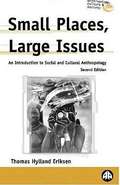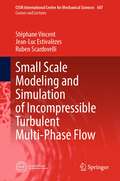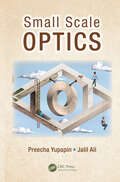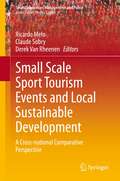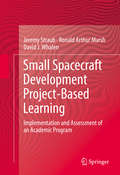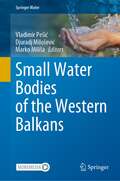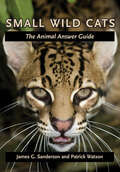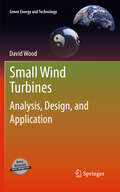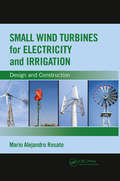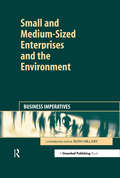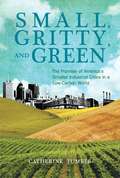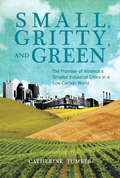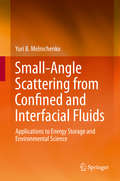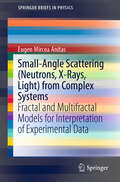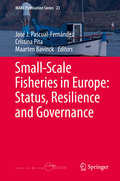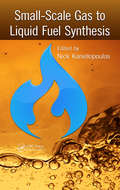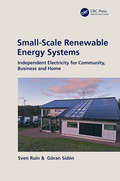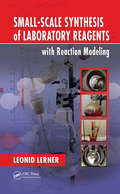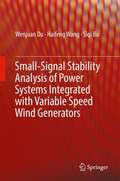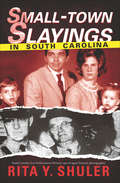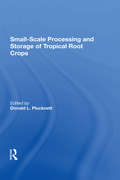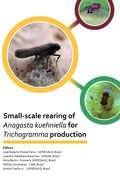- Table View
- List View
Small Places, Large Issues: An Introduction to Social and Cultural Anthropology (2nd edition)
by Thomas Hylland EriksenThis is a new edition of an introductory anthropology textbook for undergraduates. Eriksen (social anthropology, U. of Oslo) focuses on such central topics as kinship, ethnicity, ritual, and political systems, and offers examples that demonstrate the scope of anthropology and the basic approaches of the discipline. Annotation c. Book News, Inc., Portland, OR (booknews.com)
Small Satellite Missions for Earth Observation
by Rainer Sandau Arnoldo Valenzuela Hans-Peter RoeserThis book was compiled from those contributions given at the 7th IAA Symposium on Small Satellites for Earth Observation, May 4-8, 2009, Berlin (IAA - International Academy of Astronautics) which are representative for the new developments and trends in the area of small satellites for Earth observation. They reflect the potentials of a diversity of missions and related technologies. They may be based on national projects or international co-operations, single satellites of constellations, pico-, nano-, micro- or mini-satellites, developed by companies, research institutions or agencies. The main focus is on new missions to monitor our Earth's resources (chapter 1), and the environment in which our Earth is embedded (chapter 2). Chapter 3 deals with distributed space systems, the unique feature of small satellites. The university satellites chapter (chapter 4) shows the high quality which is already reached by some of the universities worldwide. Chapter 5 gives insight into new developments in the fields of instruments and technologies. The last two chapters (chapters 6, 7) deal with subjects, necessary to make use of the data coming from the satellite systems: attitude and position
Small Scale Modeling and Simulation of Incompressible Turbulent Multi-Phase Flow (CISM International Centre for Mechanical Sciences #607)
by Stéphane Vincent Jean-Luc Estivalèzes Ruben ScardovelliThe book provides basic and recent research insights concerning the small scale modeling and simulation of turbulent multi-phase flows. By small scale, it has to be understood that the grid size for the simulation is smaller than most of the physical time and space scales of the problem. Small scale modeling of multi-phase flows is a very popular topic since the capabilities of massively parallel computers allows to go deeper into the comprehension and characterization of realistic flow configurations and at the same time, many environmental and industrial applications are concerned such as nuclear industry, material processing, chemical reactors, engine design, ocean dynamics, pollution and erosion in rivers or on beaches. The work proposes a complete and exhaustive presentation of models and numerical methods devoted to small scale simulation of incompressible turbulent multi-phase flows from specialists of the research community. Attention has also been paid to promote illustrations and applications, multi-phase flows and collaborations with industry. The idea is also to bring together developers and users of different numerical approaches and codes to share their experience in the development and validation of the algorithms and discuss the difficulties and limitations of the different methods and their pros and cons. The focus will be mainly on fixed-grid methods, however adaptive grids will be also partly broached, with the aim to compare and validate the different approaches and models.
Small Scale Optics
by Preecha Yupapin Jalil AliThe behavior of light in small scale optics or nano/micro optical devices has shown promising results, which can be used for basic and applied research, especially in nanoelectronics. Small Scale Optics presents the use of optical nonlinear behaviors for spins, antennae, and whispering gallery modes within micro/nano devices and circuits, which can
Small Scale Sport Tourism Events and Local Sustainable Development: A Cross-National Comparative Perspective (Sports Economics, Management and Policy #18)
by Ricardo Melo Claude Sobry Derek Van RheenenThis book outlines the impacts of small scale sport tourism events on local sustainable development in different countries. Using half marathons organized in small and medium sized cities as an example, the chapters are robust case studies, applying a unified methodology in order to provide a clear overview of the sport tourism system in each country. The book begins with a description of the methodologies used and an overview of the countries studied. The country chapters focus on several dimensions of sport tourism in each city, including but not limited to the history of past sport tourism events in the municipality, the characteristics of the city hosting the event, the demographic profile of participants in the event, and the quantifiable economic, environmental, and sociocultural impacts of the event. Each chapter concludes with analysis and policy recommendations for holding future events that contribute to local sustainable development. The book concludes by summarizing and comparing the main results across different countries, and presenting main conclusions and overarching recommendations.Written by international experts in sports tourism, this book is geared towards academic researchers and students, interested in sport tourism, sports economics, management, and sustainable development, as well as policy makers and professionals tasked with bringing such events to their cities.
Small Spacecraft Development Project-Based Learning
by Jeremy Straub Ronald Arthur Marsh David J. WhalenThis book provides the information that is required to start a small spacecraft program for educational purposes. This will include a discussion of multiple approaches to program formation and build / buy / hybrid decision considerations. The book also discusses how a CubeSat (or other small spacecraft program) can be integrated into course and/or program curriculum and the ancillary benefits that such a program can provide. The assessment of small spacecraft programs and participatory project-based learning programs is also discussed extensively. The book presents prior work related to program assessment (both for a single program and internationally) and discusses how similar techniques can be utilized for both formative and summative assessment of a new program. The utility of these metrics (and past assessment of other programs) in gaining buy-in for program formation and funding is also considered.
Small Systems and Fundamentals of Thermodynamics
by Yu. K. TovbinSmall systems are a very active area of research and development due to improved instrumentation that allows for spatial resolution in the range of sizes from one to 100 nm. In this size range, many physical and chemical properties change, which opens up new approaches to the study of substances and their practical application. This affects both traditional fields of knowledge and many other new fields including physics, chemistry, biology, etc. This book highlights new developments in statistical thermodynamics that answer the most important questions about the specifics of small systems - when one cannot apply equations or traditional thermodynamic models.
Small Water Bodies of the Western Balkans (Springer Water)
by Vladimir Pešić Djuradj Milošević Marko MilišaThe small water bodies such as headwater streams, springs, ditches, small lakes, and ponds are critical to maintaining freshwater biodiversity. This is especially true for Dinaric karst, where they are often the only water bodies present. However, despite their importance, they remain widely overlooked and excluded from government policies like the EU Water Framework Directive. This book includes information on different aspects of these essential but still neglected habitats. This book intends to be of interest to a wide range of audiences, from researchers and conservationists to the public and decision-makers.
Small Wild Cats: The Animal Answer Guide (The Animal Answer Guides: Q&A for the Curious Naturalist)
by Patrick Watson James G. SandersonDid you know that most wild cat species are small and that lions, tigers, and other large cats are the exception? That adult bobcats, clouded leopards, and other small wild cats are completely asocial? And that they fight only as a last resort? This entertaining and informative book reveals these and hundreds of other facts about the behavior, biology, and conservation of the more than 30 small wild cat species. From bobcats to servals, small cats are spread across the globe. They range in size from the rusty-spotted cat and African black-footed cat, each of which weighs around 5 pounds when fully grown, to the Eurasian lynx, which can reach an adult weight of 60 pounds. These felids are elusive, some are nocturnal, others are arboreal, and all are rare and secretive, making them especially difficult to study. James G. Sanderson, the world’s leading field expert on small wild cats, and naturalist and wildlife artist Patrick Watson provide informative and entertaining answers to common and unexpected questions about these animals. The authors explain why some small cats live on the ground while others inhabit trees, discuss the form and function of their coat types and colors, offer scientifically sound information on human–small wild cat interactions, and even review the role that small wild cats have played in literature, religion, and mythology. The world of cats is as fascinating as it is diverse. Small Wild Cats: The Animal Answer Guide shows just how important and interesting the littlest of the nondomesticated feline family are.
Small Wind Turbines
by David WoodSmall Wind Turbines provides a thorough grounding in analysing, designing, building, and installing a small wind turbine. Small turbines are introduced by emphasising their differences from large ones and nearly all the analysis and design examples refer to small turbines. The accompanying software includes MATLAB® programs for power production and starting performance, as well as programs for detailed multi-objective optimisation of blade design. A spreadsheet is also given to help readers apply the simple load model of the IEC standard for small wind turbine safety. Small Wind Turbines represents the distilled outcome of over twenty years experience in fundamental research, design and installation, and field testing of small wind turbines. Small Wind Turbines is a suitable reference for student projects and detailed design studies, and also provides important background material for engineers and others using small wind turbines for remote power and distributed generation applications.
Small Wind Turbines for Electricity and Irrigation: Design and Construction
by Mario Alejandro RosatoThis practical book deals with the technology of small-power wind turbines as opposed to widely diffused industrial wind turbines and wind farms. It covers the most common wind turbine technologies in the small power segment: horizontal axis both for electrical generation and water pumping, vertical axis of the Darrieus type, and vertical axis of the Savonius type. With each chapter following the same didactic scheme—a theoretical explanation and practical examples showing calculation procedures—it allows anybody with basic technical knowledge to design and build a small wind turbine for any site. A set of simple spreadsheets is available for download, each providing further examples of how to solve specific design problems and allowing the reader to play with changing parameters and see what-if. This simple trial-and-error learning process allows beginners to develop the feeling of the orders of magnitude involved in the design of a small wind power system, its potential advantages on other alternative solutions, and its limitations under some special circumstances.
Small and Medium-Sized Enterprises and the Environment: Business Imperatives
by Ruth HillaryThis book tackles a largely neglected topic: small and medium-sized enterprises (SMEs) and their environmental impact. Over 90% of all firms are SMEs. Their importance to the health of national and international economies is recognized. But what of their environmental impact? Individually, this may be small but, collectively, they pose a huge and largely unregulated threat to national and indeed the global environment. There have been many failed attempts to engage SMEs in environmental stewardship. Why is this? And where are the success stories needed to set best-practice examples? Environmental protection is widely touted as being a win-win scenario for business with economic spin-offs in terms of energy and waste reduction quickly producing payback for capital expenditures. Why is the "good environmental management equals good business management" message not getting through? In Small and Medium-Sized Enterprises and the Environment Dr Ruth Hillary brings together an outstanding international collection of experts from government, international and national support agencies, academics and the business community to present arguments about the key environmental business imperatives facing the small-firm sector. The book is divided into four sections:Attitudes and Perceptions of Small Firms to the Environment and SustainabilityEnvironmental Management in the Smaller FirmPractical Strategies for Reaching SMEsCase Studies from around the World. In these sections, the book examines the threats – such as trade, supply chain issues and legislative compliance – but is also solution-oriented, with considerable discussion of the management tools smaller firms can use to improve their environmental performance. It aims to provide practical strategies for smaller firms and to that end includes a range of informative case studies from around the world. Small and Medium-Sized Enterprises and the Environment is the most comprehensive book on the subject available and will prove invaluable not only to SMEs themselves, seeking to understand a rapidly changing world, but to consultants and small-business advisors, local and central government and to all those in academia looking for ways to improve the environmental performance of small businesses.
Small, Gritty, and Green
by Catherine TumberAmerica's once-vibrant small-to-midsize cities--Syracuse, Worcester, Akron, Flint, Rockford, and others--increasingly resemble urban wastelands. Gutted by deindustrialization, outsourcing, and middle-class flight, disproportionately devastated by metro freeway systems that laid waste to the urban fabric and displaced the working poor, and struggling with pockets of poverty reminiscent of postcolonial squalor, small industrial cities--as a class--have become invisible to a public distracted by the Wall Street (big city) versus Main Street (small town) matchup. These cities would seem to be part of America's past, not its future. And yet, journalist and historian Catherine Tumber argues in this provocative book, America's gritty Rust Belt cities could play a central role in a greener, low-carbon, relocalized future. As we wean ourselves from fossil fuels and realize the environmental costs of suburban sprawl, we will see that small cities offer many assets for sustainable living not shared by their big city or small town counterparts: population density (and the capacity for more); fertile, nearby farmland available for local agriculture, windmills, and solar farms; and manufacturing infrastructure and workforce skill that can be repurposed for the production of renewable technology. Tumber, who has spent much of her life in Rust Belt cities, traveled to twenty-five cities in the Northeast and Midwest--from Buffalo to Peoria to Detroit to Rochester--interviewing planners, city officials, and activists, and weaving their stories into this exploration of small-scale urbanism. Smaller cities can be a critical part of a sustainable future and a productive green economy. Small, Gritty, and Green will help us develop the moral and political imagination we need to realize this.
Small, Gritty, and Green: The Promise of America's Smaller Industrial Cities in a Low-Carbon World (Urban and Industrial Environments)
by Catherine TumberHow small-to-midsize Rust Belt cities can play a crucial role in a low-carbon, sustainable, and relocalized future.America's once-vibrant small-to-midsize cities—Syracuse, Worcester, Akron, Flint, Rockford, and others—increasingly resemble urban wastelands. Gutted by deindustrialization, outsourcing, and middle-class flight, disproportionately devastated by metro freeway systems that laid waste to the urban fabric and displaced the working poor, small industrial cities seem to be part of America's past, not its future. And yet, Catherine Tumber argues in this provocative book, America's gritty Rust Belt cities could play a central role in a greener, low-carbon, relocalized future.As we wean ourselves from fossil fuels and realize the environmental costs of suburban sprawl, we will see that small cities offer many assets for sustainable living not shared by their big city or small town counterparts, including population density and nearby, fertile farmland available for new environmentally friendly uses.Tumber traveled to twenty-five cities in the Northeast and Midwest—from Buffalo to Peoria to Detroit to Rochester—interviewing planners, city officials, and activists, and weaving their stories into this exploration of small-scale urbanism. Smaller cities can be a critical part of a sustainable future and a productive green economy. Small, Gritty, and Green will help us develop the moral and political imagination we need to realize this.
Small-Angle Scattering from Confined and Interfacial Fluids
by Yuri B. MelnichenkoThis book examines the meso- and nanoscopic aspects of fluid adsorption in porous solids using a non-invasive method of small angle neutron scattering (SANS) and small angle x-ray scattering (SAXS). Starting with a brief summary of the basic assumptions and results of the theory of small-angle scattering from porous media, the author focuses on the practical aspects and methodology of the ambient and high pressure SANS and SAXS experiments and corresponding data analysis. It is illustrated with results of studies of the vapor and supercritical fluid adsorption in porous materials published during the last decade, obtained both for man-made materials (e. g. porous fractal silica, Vycor glass, activated carbon) and geological samples (e. g. sandstones, shales and coal). In order to serve the needs of broad readership, the results are presented in the relevant context (e. g. petroleum exploration, anthropogenic carbon capture and sequestration, ion adsorption in supercapacitors, hydrogen storage, etc. ).
Small-Angle Scattering: Fractal and Multifractal Models for Interpretation of Experimental Data (SpringerBriefs in Physics)
by Eugen Mircea AnitasThis book addresses the basic physical phenomenon of small-angle scattering (SAS) of neutrons, x-rays or light from complex hierarchical nano- and micro-structures. The emphasis is on developing theoretical models for the material structure containing self-similar or fractal clusters. Within the suggested framework, key approaches for extracting structural information from experimental scattering data are investigated and presented in detail. The range of parameters which can be obtained pave the road towards a better understanding of the correlations between geometrical and various physical properties (electrical, magnetic, mechanical, optical, dynamical, transport etc.) in fractal nano- and micro-materials.
Small-Scale Fisheries in Europe: Status, Resilience and Governance (MARE Publication Series #23)
by Maarten Bavinck José J. Pascual-Fernández Cristina PitaThis book offers a comprehensive account of the status and dynamics of people participating in the small-scale fisheries (SSF) of Europe. It covers the situation of SSF in 25 coastal countries, thereby providing a portrait of almost every coastal country on the continent and analyzing the recent evolution of the sector. Small-scale fisheries are argued to be extremely important in Europe, as they provide employment and welfare, while increasing food sovereignty and maintaining communities in coastal areas. The recent worldwide focus on SSF derives from their environmental sustainability, which distinguishes many of their activities from those of large-scale fisheries. This book analyses the diversity of SSF and shows how fishing communities have sometimes developed successful governing models, demonstrating social and economic resilience. While the book emphasizes the strengths of SSF and the synergies that occur with other marine sectors, it also presents cases of failure, in which collective action and policy have actually contributed to a weakening of the sector. In this context, the book shows how governmental policies toward SSF vary considerably from country to country, in a way that is not entirely consistent with European policies.
Small-Scale Gas to Liquid Fuel Synthesis
by Nick KanellopoulosIt is estimated that a large fraction of natural gas reserves are found in locations from where transport is not economical. If these isolated natural gas reserves could be converted to synthetic fuels, they would generate around 250 billion barrels of synthetic oil-a quantity equal to one-third of the Middle East's proven oil reserves. Small-Scale
Small-Scale Renewable Energy Systems: Independent Electricity for Community, Business and Home
by Sven Ruin Göran SidénA revolution is ongoing in the field of small-scale energy solutions, which can enable lower impact on the environment, more robust supply and self-determination. Solar power and other forms of renewable energy sources, which you can implement to generate your own electricity, are growing quickly. Electromobility is transforming the car industry and transportation systems and can also play a role in your energy system. Electricity can be used much more efficiently than before, for example by using LED light, variable speed motor drives and efficient home appliances. Smart controls are available, sometimes with free open source software. All this opens up tremendous opportunities for energy independence, which is the focus of this book. The book introduces the reader to a number of renewable energy sources, to different options for storing electricity and to smart use of electricity, particularly in the context of small isolated systems. This is important because many renewable energy sources are weather- and season-dependent and usually require storage and smart control, in order to obtain a system that is completely independent of the electricity grid. In the book, overall system design is explained, including how to combine different sources in a hybrid system. Different system sizes and architectures are also covered. A number of real cases are described, where homes, businesses and communities have achieved a high level of energy independence or are on their way to achieving it. This book will prove useful in university education in renewable energy at bachelor and master level, and also for companies and private individuals, who want to start or expand activities in the area of renewable energy.
Small-Scale Synthesis of Laboratory Reagents with Reaction Modeling
by Leonid LernerThe in-lab preparation of certain chemical reagents provides a number of advantages over purchasing various commercially prepared samples. This is especially true in isolated regions where acquiring the necessary substances from overseas can cause undue delay and inconvenience due to restrictions on the transportation of hazardous chemicals. An inv
Small-Signal Stability Analysis of Power Systems Integrated with Variable Speed Wind Generators
by Haifeng Wang Wenjuan Du Siqi BuThis book reviews and examines how power system low-frequency power oscillations and sub-synchronous oscillations may be affected by grid connection of wind power generation. Grid connection of wind power generation affects the power system small-signal stability and has been one of the most actively pursued research subjects in power systems and power electronics engineering in the last ten years. This book is the first of its kind to cover the impact of wind power generation on power system low-frequency oscillations and sub-synchronous oscillations. It begins with a comprehensive overview of the subject and progresses to modeling of power systems and introduces the application of conventional methods, including damping torque analysis, modal analysis and frequency-domain analysis, presented with detailed examples, making it useful for researchers and engineers worldwide.
Small-Town Slayings in South Carolina (True Crime Ser.)
by Rita Y. ShulerA former forensic photographer and author of Murder in the Midlands chronicles horrific killings that struck at the heart of the Palmetto State. Ax assault, kidnapping, brutal murder: how could these things happen in a small town? Although regional crimes hardly ever make it to the national circuit, they will always remain with the families and communities of the victims and a part of the area&’s history. After working with the South Carolina Law Enforcement Division as special agent/forensic photographer for twenty-four years, Rita Shuler has a passion for remembering the victims. In Small-town Slayings, Shuler takes us back in time, showing differences and similarities of crime solving in the past and present and some surprising twists of court proceedings, verdicts, and sentences. From an unsolved case that has haunted her for thirty years to a cold case that was solved after fifteen years by advanced DNA technology, Shuler blends her own memories with extensive research, resulting in a fast-paced, factual, and fascinating look at crime in South Carolina. Includes photos!
Small-scale Computational Vibration of Carbon Nanotubes: Composite Structure (River Publishers Series in Mathematical, Statistical and Computational Modelling for Engineering)
by Muzamal HussainThis book presents orthotropic vibration modeling and analysis of carbon nanotubes (CNTs) which be helpful in applications such as oscillators and in non-destructive testing, and also vibrations characteristics of armchair double-walled CNT by means of nonlocal elasticity shell model. The nonlocal shell model is established by inferring the nonlocal elasticity equations in to Kelvin’s theory, which is our particular motivation. The suggested method to investigate the solution of fundamental Eigen relations is wave propagation, which is a well-known and efficient technique to develop the fundamental frequency equations. The frequencies of three different types of SWCNTs are calculated. Also, the vibrations of the chiral single-walled carbon nanotube (SWCNTs) with non-local theory using wave propagation approach is investigated. It has been investigated that by increasing the nonlocal parameter decreases the frequencies and on increasing the aspect ratio increases the frequencies throughout the computation frequencies of clamped-free lower than that of clamped-clamped.Carbon nanotubes have a variety of applications because of their distinctive molecular structure and show unique electronic and mechanical properties because of their curvature. Nanotubes and micro-beams can be cited as one of the very applicable micro- and nano-structures in various systems, namely, sensing devices, communications and the quantum mechanics. The application of the tiny structures, specifically, carbon nanotubes in the sensors and actuators enforce the engineers to study vibrational properties of those structures experimentally and theoretically. In addition, they are utilized in different fields such as bioengineering, tissue engineering, computer engineering, optics, energy and environmental systems.
Small-scale Processing And Storage Of Tropical Root Crops
by Donald PlucknettTropical root crops—basic staples for millions of people—are highly perishable, and tremendous losses occur after harvest because of the lack of storage and processing technology. This book is the first to fully describe small-scale processing and storage methods for these root crops, particularly taro, sweet potato, and yams. The authors emphasize methods of handling and preserving the crops that require little in the way of energy or technology, and they discuss traditional methods of storage and processing in Africa, Asia, and the Pacific. They also describe small machines suitable for processing and highlight examples of higher-level technology. The book is a milestone in the search for ways to appropriately modernize traditional agriculture and food systems.
Small-scale Rearing of Anagasta kuehniella for Trichogramma Production
by Jennifer Brown Yelitza Colmenarez José Roberto Postali Parra Leandro Delalibera Geremias Aline Bertin Aloisio Coelho Jr Janet R. ReidThis technical guide describes the techniques for small-scale rearing of the egg parasitoids Trichogramma spp. in the factitious host Anagasta kuehniella. These parasitoids are among the most widely used natural enemies in the world, and in Brazil are used to control lepidopteran pests in a wide variety of crops, including sugarcane, corn, soybean, cotton, vegetables (tomatoes, potatoes), fruit (avocado, citrus, grapes), and tobacco.
